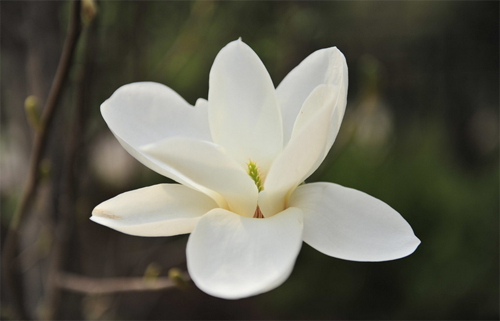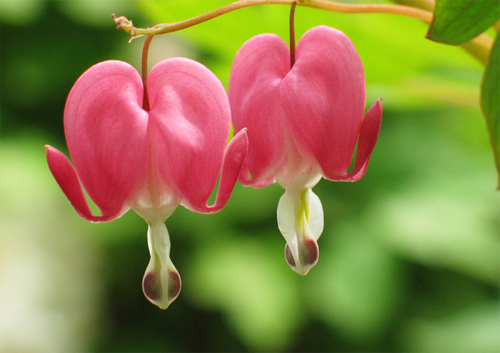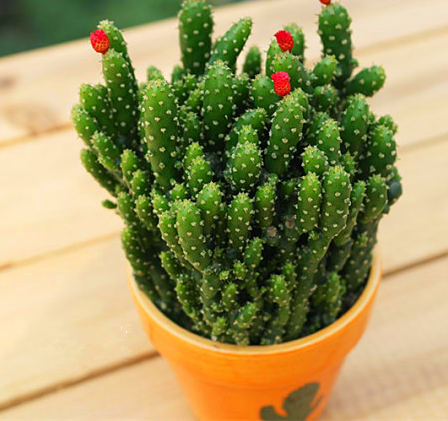How to plant diseases and insect pests in magnolia and its control methods
Magnolia is very common, many urban greening is also used in magnolia, magnolia is very large, most of them are white, is very good-looking, how to grow magnolia? What are the diseases and insect pests? How to prevent and cure it?

How to grow magnolia:
1. Environmental selection
Magnolia likes light, young trees are more resistant to shade, not resistant to strong light and western sun, too strong light or western sun, it is easy to burn trees.
Magnolia can be planted in a side light-blocking environment, but under a big tree or in the shade, it does not grow well, the tree is thin, the branches are sparse, the leaves are small and yellowing, and there are no flowers or small flowers.
It is cold-resistant and can withstand a short low temperature of-20 ℃, but it should not be planted in the tuyere, otherwise striping is easy to occur, and measures such as no entanglement in the leeward direction of Beijing can safely survive the winter in the open field.
Magnolia likes fertile, moist, well-drained slightly acidic soil, but can also grow normally in light saline-alkali soil; Magnolia is fleshy root, afraid of stagnant water, planting topography should be high, planting in low-lying areas is easy to rot roots and lead to death; Magnolia also has good soil permeability, poor growth in clay, and grows best in sandy loam and yellow sandy soil.
2. Planting attention
Magnolia is not resistant to transplantation and is generally ideal for transplanting 10 to 15 days before sprouting or when the flowers have just withered but have not spread their leaves. The seedlings should be watered once 4 to 5 days before seedling emergence, which can not only make the plants absorb sufficient water, which is beneficial to the survival after planting, but also benefit the soil to form balls when digging seedlings.
Damage the root system as little as possible, and the root wound must be smooth to facilitate wound healing.
Note: no matter how big the seedlings are, they should carry soil balls. The diameter of soil balls should be 8-10 times of the ground diameter of seedlings and should not be too small. After the earth ball is dug, it should be tied up with straw rope.
3. Soil selection
Dig the tree hole well before planting, the tree hole should be large, not small, the tree hole is too small, it is not only troublesome to plant, but also not conducive to root growth. The soil at the bottom of the tree pit had better be mature soil. If the soil is too sticky or the salt content exceeds the standard, guest soil or soil improvement should be carried out. The permeability of cultivated soil must be good, soil fertility must be sufficient, enough nutrients should be provided to plants, and there should be no impurities such as bricks, tiles, lime and so on in the soil.
4. Planting skills
Planting depth should be appropriate, generally speaking, the planting depth can be slightly higher than the original soil ball 2 to 3 cm, too deep is easy to sprout, too shallow will make the root bare, but also easy to be blown down by the wind. Large size seedlings should be set up in time, the support can be used triangle support, to prevent tilting by the wind.
5. Watering
After planting, it should be watered immediately, two water after 3 days, three water after 5 days, and normal management after three days. If the seedlings have buds, the buds should be cut off to prevent flowering and fruiting from consuming a lot of nutrients and affecting the survival rate.
Magnolia is neither resistant to waterlogging nor drought, so the principle of "like wet and afraid of waterlogging" should be strictly followed in cultivation and maintenance. In the process of cultivation and conservation, many people think that Magnolia should be watered as little as possible, which is very wrong, because Magnolia is afraid of waterlogging does not mean it likes drought, and it likes wet environment. In water management, it is necessary to master the degree that the soil is neither too dry nor too wet.
In the process of conservation, the newly planted magnolia should keep the soil moist, which is also an important measure to ensure its survival rate.
For the return of green water in early spring, anti-freezing water in early winter is indispensable, and it should be watered thoroughly. In the growing season, it can be watered once a month, the rainy season should stop watering, and it should be drained in time after the rain to prevent rotting roots caused by stagnant water. in addition, it should also be carried out in time to loosen the soil and preserve soil moisture.
Note: irrigation should also be timely during the dry period of the rainy season. Lack of water not only affects the vegetative growth of plants, but also causes buds to fall off or shrink, affecting flowering in the following year.
If the soil is poor, the hardened area is large, and the green area is small, the magnolia planted in the environment with large hardened area and small green space should be watered with foliar water while the root is watered in high temperature and drought weather. Spraying water should pay attention to the degree of atomization, the higher the degree of atomization, the better the effect is. Spray time before 8:00 in the morning and after 6:00 in the evening is the best, and can not be carried out when the light is strong at noon.
Magnolia which suffers from waterlogging should be saved at the first time, remove stagnant water in time, shade the trees, especially prevent the western sun, and cut off some leaves and buds.
6. Fertilization
When planting, base fertilizer should be applied every year, it is easy to have more buds, large flowers, long florescence and fragrance.
Fertilizing 4 times a year, applying nitrogen, phosphorus and potassium compound fertilizer once before flowering, applying phosphorus and potassium compound fertilizer once in July and August to promote flower bud differentiation, and applying circle fertilizer combined with watering winter water before winter, this fertilizer can not only improve the activity of the soil, but also the amount of fertilizer should not be small. The seedlings planted in the same year grew poorly and were foliar sprayed with 0.2% potassium dihydrogen phosphate solution to effectively enhance the tree shape.
7. Overwintering maintenance
Although Magnolia can withstand the low temperature of-20 ℃, both small magnolia and Magnolia planted in that year should strengthen the management of overwintering. In addition to pouring enough frozen water after falling leaves in the middle and last ten days of November, the tree pits should be treated with grass mulching, film mulching or soil cultivation, and the trees can be treated with white coating to prevent striping in spring. Magnolia, which has survived for many years, can only be treated with anti-freezing water and whitening.
Disease and pest control of magnolia:
Disease
Magnolia is a tree species with strong disease resistance, and a few of them will have anthracnose, chlorosis and leaf burn.
(1) anthrax
Damage to the leaves, from the leaf tip or leaf edge of the disease spots, in the summer period of high temperature and humidity is the peak of the disease. Plant water and fertilizer management is not in place, not ventilated, when the growth decline is very easy to occur this disease.
Prevention and control methods: strengthen water and fertilizer management, remove diseased leaves, remove fallen leaves and burn them at the end of autumn; spray with 75% chlorothalonil wettable granule 800 times or 70% anthrax Fumei 500 times, once every 10 days, 3 times 4 times to effectively control the disease. Special agents: Bacillus spp., carbendazim, Amisi, etc., have special effects on diseases caused by fungi.
(2) chlorosis
First of all, the leaflets fade, the leaves turn yellow, and after the disease spreads, the whole leaves turn yellow, and then gradually whiten, plant growth gradually decline, and finally die. Prevention and control methods: mainly caused by excessive stickiness of soil, excessive pH value and insufficient supply of iron.
0.2% ferrous sulfate solution can be used to irrigate roots, or 0.1% ferrous sulfate solution can be used for leaf spraying, and more farm manure should be applied.
(3) Leaf burns
At the initial stage, the leaves were scorched, and then the leaves shrunk and withered. In severe cases, the new leaves did not expand, and a large number of leaves withered and fell off.
This disease often occurs when soil hardening area is large, green space area is small, high temperature, drought, strong light for a long time, soil alkalinization or excessive flower quantity and so on.
Control methods: increase watering times, keep the soil moist; apply more organic fertilizer to improve plant resistance, whitening or entangling trees.
Insect pest
Pests include big coir moth, frost moth, red spider, longicorn beetle and so on. If pests occur, 8 dichlorvos, fenitrothion, and killing big coir moth can be used; Bt emulsion and fenitrothion can be used to kill frost moth.
Killing red spiders with 4-triclofenac and nisolan
Killing longicorn beetles with green Weilei and killing grubs with zinc parathion emulsion
Magnolia alias:
Magnolia, Magnolia, Wangchun
The planting method of magnolia and the diseases and insect pests that appear in the process of breeding are introduced here. Hurry up and have one in your own home.
What to do when magnolia grows insects? disease and pest control of magnolia / 3 insect pests and 2 diseases
In the growth process of magnolia, the last thing we want to encounter is diseases and insect pests, this kind of problem is very harmful to the plant, and even lead to the phenomenon of plant death. So what if the magnolia grows worms? How to prevent and control diseases and insect pests of magnolia? Next, the editor will take you to learn about it.
First, magnolia worms how to do, to find the reason
If we want to know what to do when magnolia grows, we must first find out the reason and know what kind of insect is growing, so that we can deal with it pertinently, because the prevention and control methods of each kind of diseases and insect pests are different. Specific prevention and control methods are described in detail below, interested friends can learn about it.
2. Disease and pest control of magnolia (pest)
1. Red wax scale
This pest mainly feeds on the juice of magnolia, and its excrement often causes coal fouling disease, which makes the plant weak, tree-shaped haggard, rarely or unable to blossom at all.
Prevention and control methods: for this kind of magnolia diseases and insect pests, if the damage is not less, we can carry out artificial scraping. If there are more affected parts, we can use 1500 times of omethoate EC to spray the plant.
two。 Red spider
Red spider is a common pest in many plants, magnolia is no exception, when this pest appears on the plant, the leaves will gradually turn yellow and white, and if it does not come out for a long time, it will lead to the phenomenon of plant wilting.
Control method: when we deal with the diseases and insect pests of this magnolia, we can spray it with 2000 times of the wettable powder.
3. Longicorn beetle
Longicorn beetle is a great harmful pest. It mainly eats the leaves of Magnolia, which will gradually erode its leaves, causing the leaves to be dilapidated, very beautiful, and even lead to the phenomenon of magnolia wilting in serious cases.
Control method: for this kind of magnolia plant diseases and insect pests, we can use 20% chrysanthemum EC and 25% chrysanthemum mixture 2000 times to spray it, usually once every 5-7 days, 1-2 times can completely eliminate this pest.
3. Disease and pest control of magnolia flower (disease)
1. Anthrax
Anthracnose is a disease that may occur in many plants, and Magnolia is no exception. There are many round brown disease spots on the leaves of Magnolia, the size of which is 2-8mm, which will gradually spread over time, and finally lead to plant rot.
Control methods: in the prevention and control of diseases and insect pests of this magnolia, we can use 70% anthrax Fumei 600 times liquid to spray it, usually spray once every 7-10 days, and then recover after 3-4 times.
two。 Leaf spot disease
Leaf spot is a kind of disease caused by fungi, many irregular brown spots will appear on the leaves of the plant, and with the passage of time, the disease spot will gradually spread to the petiole and stem, and in serious cases, it will cause plant death.
Control methods: when we deal with the diseases and insect pests of this magnolia, we can use the 4% pyrimidine nucleoside antibiotic 20ml-41% polypyrimidine 20ml to spray the diseased plants with water, usually once every 5-7 days, and then recover after 2-3 times.
The common diseases and insect pests of flowers in spring and their control methods the temperature in spring is suddenly warm and cold, how to prevent the diseases and insect pests that harm flowers from April to May, the following is the flower protection net and their own practical experience, there are the following kinds of diseases and insect pests that harm flowers in this period. I hope it will be helpful to the friends who grow flowers. Common diseases and insect pests of flowers in spring and their control methods aphids hibiscus, green peach, rose and honeysuckle are easily harmed by aphids. With the rise of temperature, aphids are also increasing. Prevention and treatment: imidacloprid and acetamiprid are sprayed, and a very small amount of washing powder can be added to enhance the efficacy. Common diseases and insect pests of flowers and plants in spring and their control methods Red Spider has been harmful to jasmine, asparagus, rose, Dahlia and so on since the first ten days of April. Prevention and control methods: the use of acarine, avermectin for prevention and control. Common diseases and insect pests of flowers and plants in spring and their control methods most of the shell insects on Magnolia Magnolia, rose, yellow poplar and crape myrtle began to hatch from mid-April to mid-May. Prevention and control methods: 1. Brush off the insect body manually before hatching. 2. Spraying chlorpyrifos and cyhalothrin during the larval incubation period. Common diseases and insect pests of flowers in spring and their control methods when the temperature reaches 20 ℃, newly sown flowers, seedlings and some flowers with rotten roots are very easy to develop blight when the soil moisture is high. Control methods: 1. Use the special seed coating agent for flowers to mix seeds before sowing. 2. Control watering at the seedling stage so as not to make the soil too wet. 3. At the beginning of the disease, irrigate 1% ferrous sulfate or spray mancozeb. Common diseases and insect pests of flowers in spring and their control methods Rust Rust infects roses when they are budding. Prevention and control methods: 1. When the rose sprouts, the first yellow bud should be removed and burned in time to eliminate the source of infectious disease. 2. Spray 15% triadimefon 700Mel 1000 times solution in the initial invasion period. Common diseases and insect pests of flowers in spring and their control methods powdery mildew of rose and impatiens mostly occurred from May to June, and it was easy to cause yellow leaves, withered leaves, twisted shoots and other symptoms in early summer. Prevention and control methods: 1. Pay attention to the ventilation and light transmission of flowers. 2. Apply less nitrogen fertilizer and more phosphorus and potassium fertilizer. 3. Spray 15% strychnine at the first dyeing stage with 700Mel 1000 times solution.
- Prev

How long is the culture method and propagation florescence of purse tree peony
Although purse peony has the word peony, it really has nothing to do with peony, and the blooming flowers do not want to. The blooming flowers of purse peony are hanging upside down and are very good-looking. let's take a look at the culture method and breeding method of purse peony. How long is the florescence of purse peony?
- Next

When will the culture method of Ji coral blossom
Ji coral looks like a cactus, but it is much slimmer than a cactus and looks very spiritual. what is the breeding method of Ji coral? When will it blossom? The culture method of Ji coral: the selection of basin soil, when Ji coral is cultivated, the basin soil should be sandy soil with good drainage and air permeability and rich in calcium.
Related
- Fuxing push coffee new agricultural production and marketing class: lack of small-scale processing plants
- Jujube rice field leisure farm deep ploughing Yilan for five years to create a space for organic food and play
- Nongyu Farm-A trial of organic papaya for brave women with advanced technology
- Four points for attention in the prevention and control of diseases and insect pests of edible fungi
- How to add nutrient solution to Edible Fungi
- Is there any good way to control edible fungus mites?
- Open Inoculation Technology of Edible Fungi
- Is there any clever way to use fertilizer for edible fungus in winter?
- What agents are used to kill the pathogens of edible fungi in the mushroom shed?
- Rapid drying of Edible Fungi

